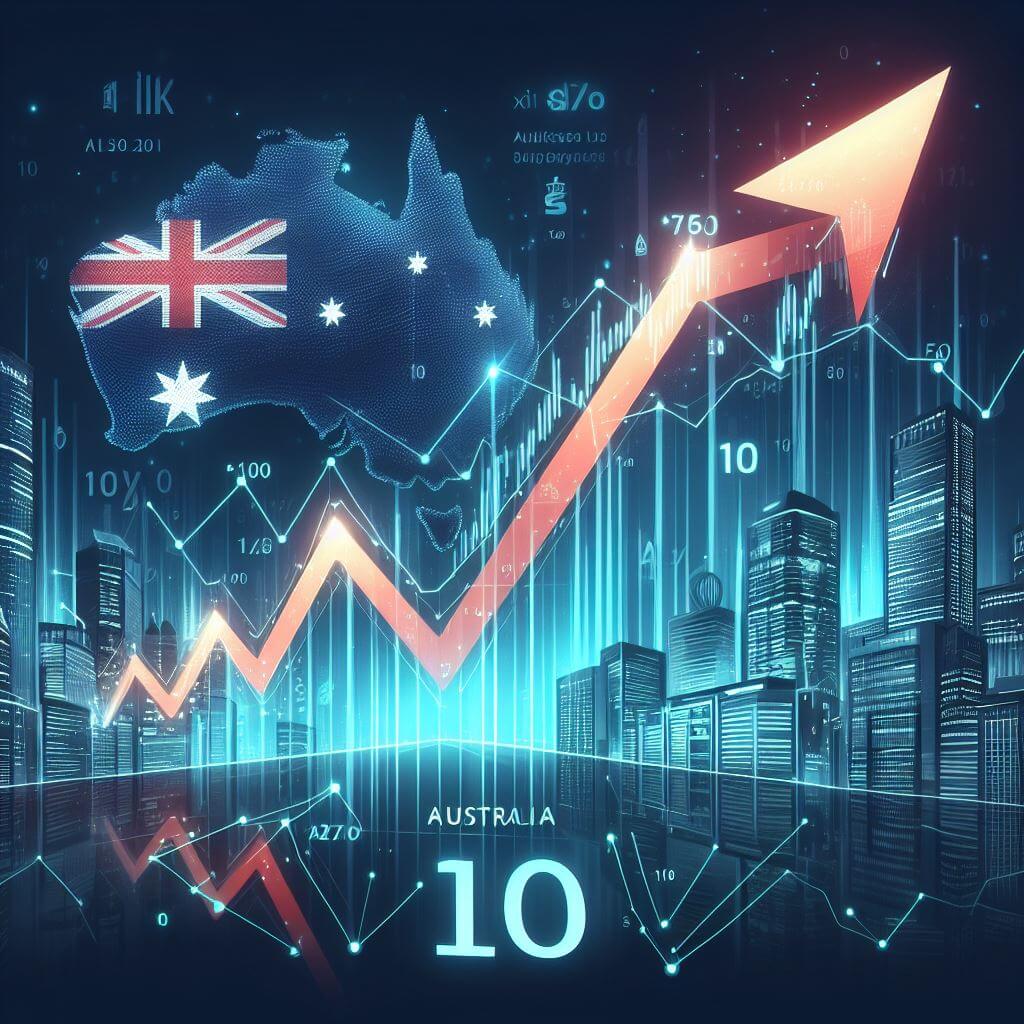Best Performing ETFs In Australia Over The Last 10 years
Last Updated on 20 February 2024 by Ryan Oldnall
Which ETFs have performed the best over the decade? In this article, we will analyze the overall best-performing ETFs in Australia over the last 10 years, covering various categories such as Australian Equity ETFs, Global ETFs, Small/Mid Cap ETFs, and Emerging Market ETFs.
The data analysis utilizes the 10-year performance data from Morningstar, obtained in December 2023 [1], in conjunction with ETF fund classifications from ASX data [2].
Best Performing ETFs In Australia Over The Last 10 Years
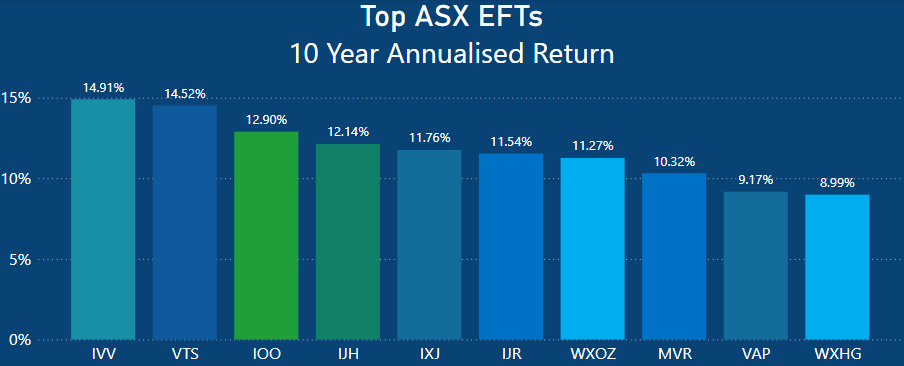
This chart examines the overall best-performing Australian ETF across all sectors, indexes, and markets. As we can see, ASX-listed iShares Core S&P 500 ETF, IVV takes the number one spot with a 14.91% annualized return over 10 years.
IVV, well-known for tracking the S&P 500, is often a ‘core’ holding for many ETF investors.
Next is the very popular Vanguard US Total Market Shares Index ETF AUD, VTS, which returned 14.52% over 10 years. VTS is popular as the ETF invests in around 4,000 companies listed in the United States [3].
However, while this fund is on the ASX, it is domiciled in the US, meaning that it requires a special tax form known as W8-BEN to avoid double taxation. Interestingly, those who use the Vanguard personal investor platform cannot even purchase this ETF through the platform.
The ASX-listed version of iShares Global 100 ETF, IOO returned 12.90% on average over 10 years, which was closely followed by iShares Core S&P Mid-Cap ETF, IJH, with a 12.14% annualized return.
iShares Global Healthcare ETF, IXJ returned 11.76% over the 10 years on average. IXJ provides exposure to pharmaceutical, biotechnology, and medical device companies across the globe.
Like IJH, the iShares Core S&P Small-Cap ETF, IJR, is another popular option for those wanting to have an investment tilt towards small and mid-cap companies. IJR had an 11.54% 10-year annualized return. IJR invests in small-cap US companies.
SPDR S&P World ex Australia Carbon Control, WXOZ returned 11.27% on average. WXOZ is designed to include 1,000 companies and industries not accessible in Australia and screens out companies that derive material revenue from objectionable practices, industries, or product lines, as well as those with relatively poor ESG ratings [4].
VanEck Australian Resources ETF, MVR returned a 10-year average of 10.32%. MVR invests in Australia’s biggest resource companies such as BHP and Rio Tinto. MVR is one of only two ETFs on the list that targets Australia domestically.
Vanguard Australian Property Securities Index ETF, VAP is the only other Australian-focused ETF returning 9.17%. VAP invests in a diversified blend of Australian real estate investment trusts (A-REITs) with residential, office, retail, and industrial assets.
Rounding out the top 10 best overall ETFs is SPDR S&P World Ex Aus Carbon Control (Hedged), WXHG with an 8.99% annualized return. WXHG has the same investment principles as WXOZ while hedging the Australian Dollar risk.
Best Performing Australian Equities ETFs In Australia Over The Last 10 Years
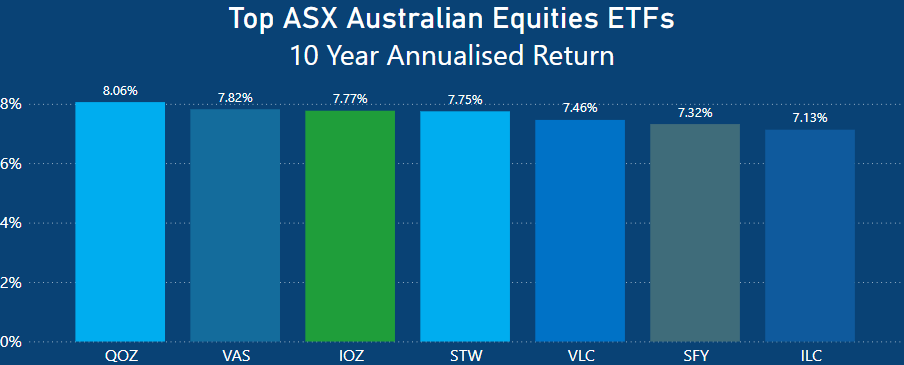
The top-performing Australian equities over the past decade showcase a diverse mix of ETF strategies. Leading the pack is BetaShares FTSE Rafi Australia 200 ETF, QOZ, delivering an impressive 8.06% return.
As per BetaShares, QOZ aims to expose investors to a diversified portfolio of Australian equities, employing a unique weighting system reflective of economic importance rather than market capitalization. Constituent weighting is grounded in accounting values and is termed “Fundamental indexing” [5].
Following closely is the largest and most popular ETF on the ASX, Vanguard Australian Shares Index ETF, VAS, boasting a 10-year annualized return of 7.82%. This slightly surpassed the returns of iShares Core S&P/ASX 200 ETF, IOZ, and SPDR S&P/ASX 200, STW, which posted 7.77% and 7.75%, respectively.
I performed a comprehensive analysis in my articles, conducting a detailed comparison between IOZ and VAS, as well as between STW and VAS in a head-to-head analysis.
Vanguard MSCI Australian Large Companies Index ETF, VLC, delivered a respectable 7.46% 10-year annualized return. For those unfamiliar with VLC, it tracks the largest companies listed on the ASX, including BHP, CBA, and CSL.
Concluding the list are SPDR S&P/ASX 50, SFY, and iShares S&P/ASX 20 ETF, ILC, returning 7.32% and 7.13%, respectively. SFY provides exposure to the top 50 listed ASX companies, while ILC offers exposure to the top 20.
Best Performing Global ETFs In Australia Over The Last 10 Years
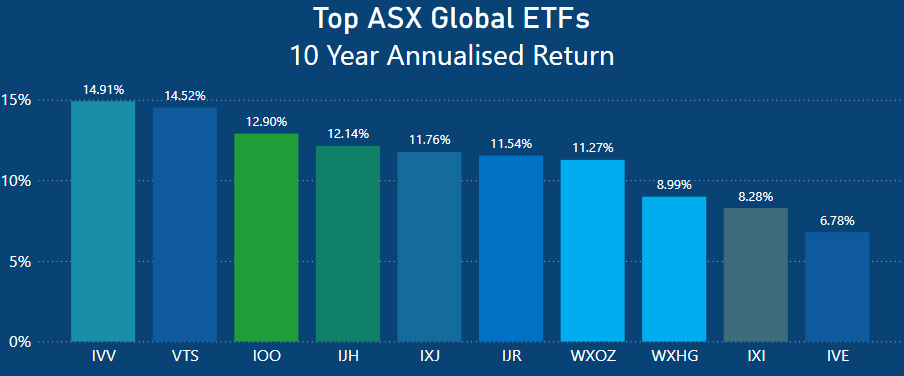
Looking at the global ETF list, you might notice the absence of a couple of expected names, namely, Vanguard MSCI Index International Shares ETF (VGS) and BetaShares Nasdaq 100 ETF (NDQ). This is because neither has a 10-year annualized return, as they haven’t been in existence for a decade.
However, if you’re interested in their 5-year performance, you can find more details in my article on the Best Performing ETFs in Australia Over the Last 5 Years.
Many of the names that dominated the Top 10 overall ETF list are featured here, especially those solely tracking the US stock market (with the exception of IXJ). IVV, VTS, IOO, IJH, IXJ, and IJR make up the top 6 globally performing global ETFs.
Following closely are WXOZ and WXHG, sharing the same underlying investment principles, with WXHG being the hedged version.
Two ETFs not yet covered are iShares Global Consumer Staples ETF (IXI) and iShares S&P 500 Value ETF (IVE), which returned 8.28% and 6.78%, respectively.
IXI focuses on exposure to companies in the S&P Global 1200 Consumer Staples Sector Index, producing essential products like food, tobacco, and household items [6]. However, for those who are ESG conscious, this may not be the ideal choice.
On the other hand, IVE provides exposure to a broad range of companies in Europe, Australia, Asia, and the Far East, including large- or mid-capitalization companies [7].
Best Performing Small/ Mid Cap ETFs In Australia Over The Last 10 Years
What Are Small/ Mid Cap Companies?
Australian small and mid-cap companies, as categorized in the stock market, are defined based on their market capitalization, which represents the total value of a company’s outstanding shares.
Small-cap companies generally fall below a specified threshold, often ranging from $300 million to $2 billion, while mid-cap companies occupy an intermediate position, larger than small-caps but smaller than large-caps, often with market capitalizations between $2 billion and $10 billion.
These categorizations are fluid and can vary, considering factors such as revenue, total assets, and industry-specific norms.
Small and mid-cap companies are typically associated with higher risk but may offer greater growth potential. They are often tracked by specific indices, such as the S&P/ASX Midcap 50 Index in Australia.
Investors should be aware that definitions may differ based on the criteria used by specific indices, funds, or financial professionals.
Top Small / Mid Cap ETFs In Australia Over The Last 10 Years
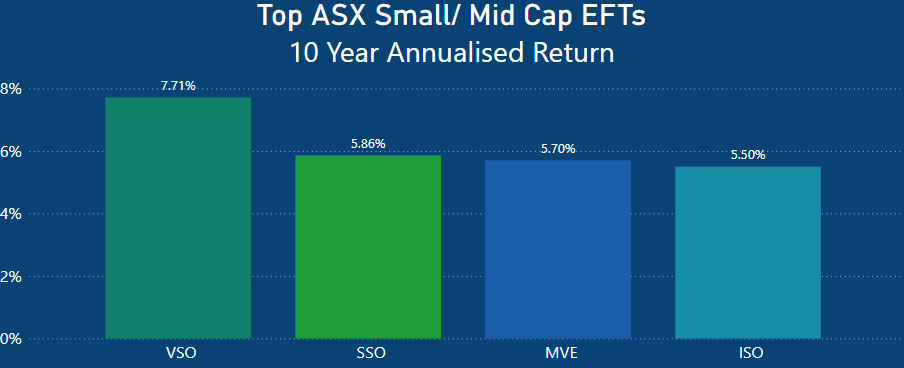
The best small/mid-cap ETF in Australia over the past 10 years belongs to Vanguard MSCI Australian Small Companies Index ETF, VSO, with a 7.71% return. VSO seeks to track the return of the MSCI Australian Shares Small Cap
Second is the SPDR S&P /ASX Small Ordinaries Fund, SSO, which returned 5.86%. Like VSO, it tracks small-cap companies.
In the third place is the VanEck S&P/ASX MidCap ETF, MVe, with a 5.70% annualized return, tracking mid-cap Australian listed companies.
Lastly, the iShares S&P/ASX Small Ordinaries ETF, ISO, rounds out the top small/mid-cap ASX listed ETFs with a 5.50% 10-year annualized return.
Best Performing Emerging Markets In Australia Over The Last 10 Years
What Are Emerging Markets?
Emerging markets for investments refer to economies in the process of rapid development, often characterized by above-average growth rates, market reforms, and increased integration into the global economy.
These markets are typically transitioning from developing to more advanced stages. Common features include high growth potential driven by factors like industrialization and urbanization, ongoing economic reforms to attract foreign investment, and a growing middle class.
Emerging markets often exhibit dynamic demographics with a youthful and expanding population, contributing to a potentially large and productive labor force. Financial and institutional changes, such as the development of stock markets and regulatory improvements, are also observed.
Historical examples include countries in Asia, Latin America, Africa, and Eastern Europe. Investors seek exposure to these markets for potential higher returns, but they also come with higher risk due to factors like political instability and currency volatility.
Top Emerging Markets In Australia Over The Last 10Years
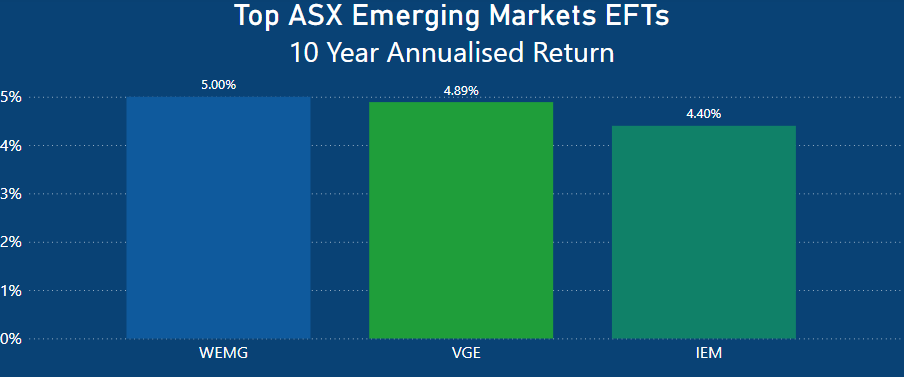
Emerging markets have not delivered robust annualized returns in the past 10 years, with the highest performer being SPDR S&P Emerging Markets Carbon Control, WEMG, achieving only 5.00%. This 10-year annualized return of 5.00% is just over a third of what IVV achieved in the same time frame.
Vanguard FTSE Emerging Markets Shares ETF AUD, VGE, was slightly behind with a return of 4.89%, and iShares MSCI Emerging Markets ETF AUD, IEM, trailed at 4.40%. Overall, it has been a challenging decade for emerging markets, as indicated by the returns.
Summary – The Round Up
Over the past decade, ETFs emphasizing the performance of US-listed companies have dominated the landscape as the best-performing. IVV stands out, securing the top spot with a 10-year annualized return of 14.91%, closely trailed by the US-domiciled VTS.
Australia’s presence in the list of top-performing ASX-listed ETFs was only achieved through the notable performance of MVR, which focuses on Australia’s resources, and VAP, dedicated to Australian REIT investment.
In essence, investors in the US through ETFs like IVV or globally with IOO are exposed to a diverse range of some of the world’s largest and most promising companies. Nevertheless, as evident, Australian-focused ETFs have consistently delivered robust returns throughout the last decade.
This article does not serve as an endorsement or recommendation for products mentioned in the article. The information presented here is based on referenced sources and is accurate as of the date of January 9, 2024. Please note that these articles are written sometime before their publication date.
The information provided in this content is for informational purposes only and should not be considered as financial, investment, or professional advice. We recommend consulting with a qualified expert or conducting your own research before making any financial decisions.
The accuracy, completeness, or reliability of the information cannot be guaranteed, and the provider shall not be held responsible for any actions taken based on the information contained in this content.
- https://www.morningstar.com.au
- https://www.asx.com.au/issuers/investment-products/asx-funds-statistics
- https://www.vanguard.com.au/personal/invest-with-us/etf?portId=0970
- https://www.ssga.com/au/en_gb/intermediary/etfs/funds/spdr-sp-world-ex-australia-carbon-control-fund-wxoz
- https://www.betashares.com.au/fund/ftse-rafi-australia-etf/
- https://www.blackrock.com/au/individual/products/273429/ishares-global-consumer-staples-etf
- https://www.blackrock.com/au/individual/products/273432/ishares-msci-eafe-etf

